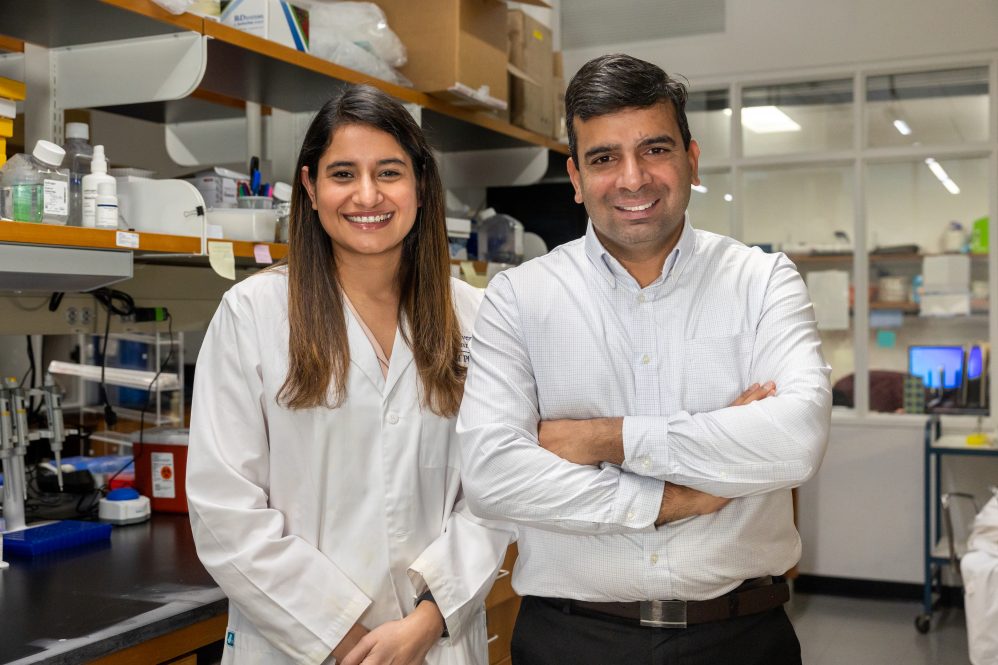A team of researchers, including those at the University of Connecticut, has developed a nanoparticle-based treatment that targets multiple culprits in glioblastoma, a particularly aggressive and deadly form of brain cancer.
The new treatment uses bioadhesive nanoparticles that adhere to the site of the tumor and then slowly release the synthesized peptide nucleic acids that they’re carrying. These peptide nucleic acids target certain microRNAs – that is, short strands of RNA that play a role in gene expression. Specifically, they’re directed at a type of overexpressed microRNA known as “oncomiRs” that lead to the proliferation of cancer cells and growth of the tumor. When the peptide nucleic acids attach to the oncomiRs, they stop their tumor-promoting activity.
The laboratories of professors Raman Bahal of the UConn School of Pharmacy and Mark Saltzman of Yale collaborated on the treatment system. Unlike similar efforts, which target only one oncomiR at a time, this treatment targets two, making its effect on cancer cells stronger. The test mice who received the treatment lived for a significantly longer time than the control mice.
“It can knock down both targets at the same time, which turns out to have a remarkably more powerful result, as we saw with the increased survival results,” says Saltzman, a professor of biomedical engineering, chemical and environmental engineering, and physiology. “These results are the best I’ve ever seen in this sort of aggressive brain tumor.”
One challenge in developing the treatment was designing the anti-cancer agents, known as antimiRs, so that two different ones could fit in a single nanoparticle.
“We synthesized all these compounds and came up with the idea that you don’t have to target one oncomiR at a time,” says Bahal, an associate professor of pharmaceutics. “Now we can think about multiple oncomiR targets.”
For this work, the researchers targeted the oncomiRs known as miR-10b and miR-21, which are both very common in glioblastoma. Future treatments, though, can be easily tailored for specific patients. For instance, if a biopsy of a patient’s tumor produces a profile showing the proliferation of different oncomiRs, the treatment could be appropriately altered.
Saltzman calls the treatment “a marriage of two technologies.”
“One is the bioadhesive nanoparticle technology, which we had developed earlier, and marrying it to this peptide nucleic acid technology that Raman has perfected,” he says.
Because the treatment is localized to the tumor site, Bahal noted that both the synthesized nucleic acids and the nanoparticles that deliver them to the tumor site are nontoxic. Also critical to the treatment’s success is that the particles and the agent it releases remain at the tumor site for about 40 days. Conventional site-specific treatments tend to wash away fairly quickly.
“These are high-binding molecules that are scalable and effective simultaneously,” says Bahal. “It’s targeted and stays there. Traditional molecules have had many challenges in terms of toxicity.”
Ideally, the delivery system would be applied as part of a larger treatment regimen.
“We designed it to be an add-on to what physicians do already,” Saltzman says. “They would do a surgery, then they infuse our nanoparticles, and then they give chemotherapy and/or radiation in the way that they normally do. We’re expecting that this would lead to a better result because the nanoparticle/anti-microRNA is sensitizing the cells to the chemotherapy and the radiation therapy.”
The study’s other authors include Shipra Malik ’23 (Pharm.D.), a former graduate student in Bahal’s lab, and Vijender Singh, Associate Director of Computational Biology Core at UConn.
“This study opens new avenues for RNA-targeted technology in developing personalized therapy for brain cancer,” says Malik.



